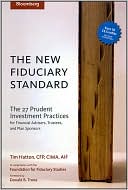List Books » The New Fiduciary Standard: The 27 Prudent Investment Practices for Financial Advisers, Trustees, and Plan Sponsors
Category Books
- Fiction Books & Literature
- Graphic Novels
- Horror
- Mystery & Crime
- Poetry
- Romance Books
- Science Fiction & Fantasy
- Thrillers
- Westerns
- Ages 0-2
- Ages 3-5
- Ages 6-8
- Ages 9-12
- Teens
- Children's Books
- African Americans
- Antiques & Collectibles
- Art, Architecture & Photography
- Bibles & Bible Studies
- Biography
- Business Books
- Christianity
- Computer Books & Technology Books
- Cookbooks, Food & Wine
- Crafts & Hobbies Books
- Education & Teaching
- Engineering
- Entertainment
- Foreign Languages
- Game Books
- Gay & Lesbian
- Health Books, Diet & Fitness Books
- History
- Home & Garden
- Humor Books
- Judaism & Judaica
- Law
- Medical Books
- New Age & Spirituality
- Nonfiction
- Parenting & Family
- Pets
- Philosophy
- Political Books & Current Events Books
- Psychology & Psychotherapy
- Reference
- Religion Books
- Science & Nature
- Self Improvement
- Sex & Relationships
- Social Sciences
- Sports & Adventure
- Study Guides & Test Prep
- Travel
- True Crime
- Weddings
- Women's Studies
The New Fiduciary Standard: The 27 Prudent Investment Practices for Financial Advisers, Trustees, and Plan Sponsors »

Authors: Tim Hatton, The Foundation for Fiduciary Studies
ISBN-13: 9781576601839, ISBN-10: 1576601838
Format: Hardcover
Publisher: Wiley, John & Sons, Incorporated
Date Published: May 2005
Edition: (Non-applicable)
Author Biography: Tim Hatton
Tim Hatton, a Certified Financial Planner practitioner and Certified Investment Management Analyst, earned the designation of Accredited Investment Fiduciary at the Center for Fiduciary Studies, the nationally recognized training organization affiliated with the Foundation for Fiduciary Studies. He is founder and president of Hatton Consulting Inc., a registered investment adviser, in Phoenix. Prior to starting that firm, he served thirteen years with Morgan Stanley, most recently as senior vice president of investments. He holds a BS in Business Administration from the University of Arizona.
Book Synopsis
Financial advisers, trustees, and plan sponsors—in fact, anyone who provides investment advice—may be held to a fiduciary standard of care for the financial well-being of their clients, beneficiaries, or employees. Accountants, attorneys, and wealth managers all need to know about these responsibilities. But what, exactly, is meant by the term fiduciary standard? What must advisers do to be sure their procedures meet legal and ethical standards?
This book identifies the 27 Prudent Practices, organized under the Five Steps, that were developed by the Foundation for Fiduciary Studies—measures that professionals can take to demonstrate that they accept, understand, and are fulfilling the role of a fiduciary.
- Financial advisers and others offering investment advice will add meaningful value to their practice and show tangible evidence of what sets them apart from the pack.
- Attorneys, CPAs, and others serving as trustees will possess the knowledge to determine whether or not their clients' investment portfolios are being managed appropriately.
- Plan sponsors will know what to look for in selecting investment consultants and in giving employees the disclosures and information they need.
The most far-reaching trend in the financial-advisory business today is the move toward a fiduciary standard of care. This book establishes for the industry a credible investment-decision process that will meet the growing expectations of investors and regulators for integrity, transparency, and disclosure of fees and conflicts that affect their returns.
Table of Contents
Foreword (Donald B. Trone).
A Summary of the Five Steps and Twenty-Seven Practices.
Preface.
Acknowledgments.
Introduction.
PART ONE: MODERN PORTFOLIO THEORY.
Chapter One: Early Years.
Chapter Two: Practical Applications.
PART TWO: THE FIVE STEPS AND TWENTY-SEVEN PRACTICES.
STEP ONE: Analyze Current Position: Practices 1.1-1.6.
STEP TWO: Diversify—Allocate Portfolio: Practices 2.1-2.5.
STEP THREE: Formalize Investment Policy: Practices 3.1-3.7.
STEP FOUR: Implement Policy: Practices 4.1-4.4.
STEP FIVE: Monitor and Supervise: Practices 5.1-5.5.
APPENDIX I: Sample Investment Policy Statements.
APPENDIX II: Subsequent Performance of Mutual Funds: Past Winners' Uncertain Future.
NOTES.
Continuing-Education Exam for CFP Continuing-Education Credit and PACE Recertification Credit.
INDEX.
Subjects
 Business & Commercial Law
Business & Commercial Law  Industrial Law
Industrial LawBusiness Books
 Business & Commercial Law
Business & Commercial Law  Securities & Finance Law
Securities & Finance LawBusiness Books
 Personal Finance & Investing
Personal Finance & Investing  Estate Planning
Estate PlanningBusiness Books
 Professional Finance & Investing
Professional Finance & Investing  Financial Industries
Financial IndustriesLaw
 Business, Commercial & Financial Law
Business, Commercial & Financial Law  Industrial Law
Industrial LawLaw
 Business, Commercial & Financial Law
Business, Commercial & Financial Law  Securities & Finance Law
Securities & Finance LawLaw
 General & Miscellaneous Law
General & Miscellaneous Law  Wills, Estates, & Trusts
Wills, Estates, & TrustsNonfiction
 Law
Law  Business, Commercial & Financial Law
Business, Commercial & Financial LawNonfiction
 Law
Law  General & Miscellaneous Law
General & Miscellaneous LawNonfiction
 All Nonfiction
All Nonfiction  Business, Commercial & Financial Law
Business, Commercial & Financial LawPolitical Books & Current Events Books
 Law
Law  Business, Commercial & Financial Law
Business, Commercial & Financial LawPolitical Books & Current Events Books
 Law
Law  General & Miscellaneous Law
General & Miscellaneous Law
